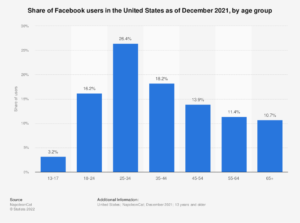
Facebook has evolved as time has progressed, gradually changing from an online social hangout for college students to a digital social center for everyday people and businesses alike. Establishing a presence on Facebook is in the interest of a normal person working a 9 to 5, a business owner, tweens, teens, and just about everyone else.
However, the platform’s demographics have shifted across the years as detailed below. Let’s take a look at what the social platform’s demographics mean in the context of Facebook marketing.
Facebook’s Demographic Progression
When Facebook first began, it was an online space for college students to interact with one another, share notes, coordinate meetups, and potentially meet a romantic flame. My, how times have changed. Though college students still use Facebook, the platform’s demographics have shifted away from college-age teenagers and early twenty-somethings to just about everyone.
In particular, businesses have embraced Facebook as it presents an opportunity to engage with potential and current customers through posts, comments, status updates, videos, images, and events. Add in the fact that adults have flocked to Facebook in recent years and the platform demographic is radically different from when it first began.
Though other social media platforms such as Twitter, Instagram, Snap, and TikTok are eating into Facebook’s popularity, especially in terms of younger social media users, the social giant is still the hub of online interactions. At the moment, Facebook has 2.9 billion monthly active users, or MAUs for short. The question is just how much Facebook’s younger audience will thin out in the years ahead.

Why has Facebook’s Demographic Shifted Toward Older Individuals?
Let’s shift our attention to why Facebook’s demographic is skewing older. For one, Facebook has expanded access to all people, shifting away from its original user base that signed up for the platform using college email addresses.
Nowadays, everyone can join Facebook and that makes the platform less desirable to younger social media users who want to interact with others in their age group. Add in the fact that other online platforms geared toward younger audiences have improved their value offering and there is even more incentive for youngsters to try out WeChat, Instagram, Snapchat, Kik, Line, WhatsApp, Twitter, etc.
According to The Verge, the percentage of teens using the Facebook app in the United States has dropped by 13% in merely three years. If projections are correct, teens’ use of the platform will decline by another 45% across the ensuing two years. Furthermore, young adults in the age range of 20 to 30 are projected to use the platform 4% less in the two years ahead.
Statistics also show the younger a Facebook user is, the less time he or she spends using the app. In other words, Facebook’s demographic is clearly moving toward older individuals. The mere fact that a tween, teen, or young adult’s parents, aunts, uncles, and grandparents are using Facebook is clearly part of the motivation to segue toward more youth-dominated socials.
In particular, Instagram is especially popular with teens. However, it must be noted that Facebook’s corporate parent, Meta, also owns Instagram. Though Instagram is certainly popular, it is worth noting Facebook research shows teens spend two times as much time on TikTok than on Instagram.
Who Uses Facebook the Most?
Most people are a bit surprised to learn that it is men, not women, who have the largest share of marketing reach through Facebook. In particular, men in the age cohort of 25 to 34 have the most significant advertising share on the platform. In other words, businesses that are looking to connect with young adult males are likely to enjoy success when placing ads on Facebook.
All in all, men between the ages of 25 and 34 comprise slightly more than 18% of Facebook’s advertising audience. Females in the 25 to 34 age cohort represent merely 12.6% of the platform’s audience for ads. It is also worth mentioning Facebook’s lowest ad reach is with both men and women in the age cohort of 13 and 17 and senior citizens who are age 65 and older.
Facebook is Pushing to Recapture the Youth Market
Facebook isn’t giving up on young adults, teens, and tweens without a fight. The social platform is proactively courting youngsters including pre-teens to its app as well as Instagram. The company has gone as far as creating youth teams specifically for targeting younger audiences who have not yet joined the platform. Facebook even went to the extent of creating a standalone messaging app specifically for kids. If everything goes as planned, Meta’s Instagram for kids will steer many more youngsters to Facebook in the years ahead.





Leave a Reply